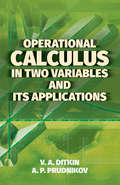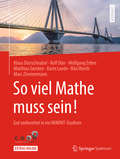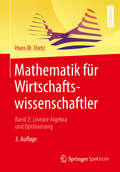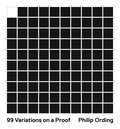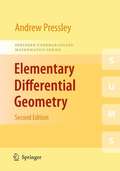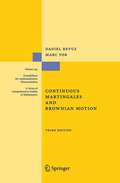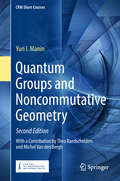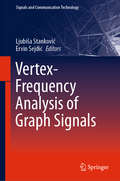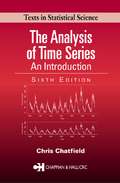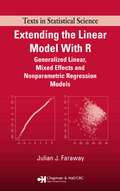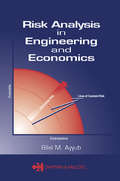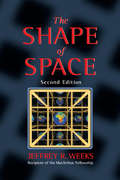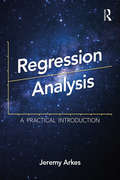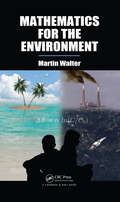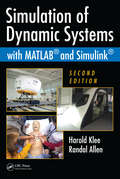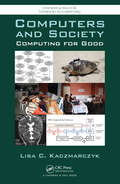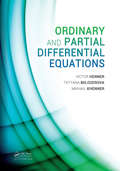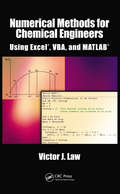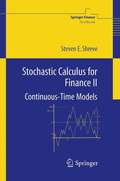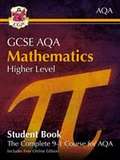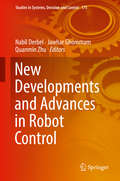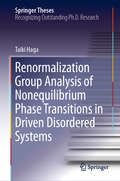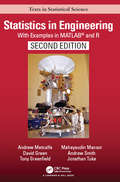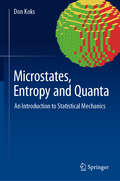- Table View
- List View
Operational Calculus in Two Variables and Its Applications (Dover Books on Mathematics)
by A. P. Prudnikov V. A. DitkinA concise monograph by two Russian experts provides an account of the operational calculus in two variables based on the two-dimensional Laplace transform. Suitable for advanced undergraduates and graduate students in mathematics, the treatment requires some familiarity with operational calculus in one variable.Part One of the two-part approach presents the fundamental theory in two chapters, examining the two-dimensional Laplace transform and offering basic definitions and theorems of the operational calculus in two variables and its applications. Part Two presents tables of formulae for various categories of functions, including rational and irrational functions; exponential and logarithmic functions; cylinder, integral, and confluent hypergeometric functions; and other areas.
So viel Mathe muss sein!: Gut vorbereitet in ein WiMINT-Studium
by Marc Zimmermann Rita Wurth Karin Lunde Matthias Gercken Wolfgang Erben Rolf Dürr Klaus DürrschnabelMithilfe dieses Arbeitsbuchs wird der Leser auf die mathematischen Herausforderungen in einem WiMINT-Studium vorbereitet. Kurze, verständlich formulierte Texte frischen Schulwissen wie logisches Begründen, Bruchrechnen, Differenzialrechnung oder lineare Gleichungssysteme wieder auf. Hierbei helfen eine Vielzahl an Beispielen und Aufgaben mit Lösungen sowie Selbsttests am Anfang jedes Kapitels, mögliche Stolperfallen schon frühzeitig zu identifizieren. Thematisch orientiert sich das Arbeitsbuch am sogenannten cosh-Mindestanforderungskatalog, welcher von Lehrenden aus Schule und Hochschule gemeinsam entwickelt wurde. Dieser hält nach übereinstimmender Meinung vieler deutscher Hochschulen, Dachverbände und Dozenten das für ein WiMINT-Studium notwendige mathematische Vorwissen fest. Neben allgemeinen mathematischen Kompetenzen werden elementare Algebra, Geometrie, Analysis, lineare Algebra und analytische Geometrie abgedeckt.
Mathematik für Wirtschaftswissenschaftler: Band 2: Lineare Algebra und Optimierung
by Hans M. DietzDieses Buch entwickelt verständlich und gut nachvollziehbar diejenige Mathematik, die für ein erfolgreiches Studium der Wirtschaftswissenschaften unverzichtbar ist. Hierbei wird die mathematische Darstellung stets durch ökonomische Anwendungen motiviert. Zahlreiche farbige Abbildungen und Übersichten visualisieren den Stoff; ausführliche Erläuterungen und Übungsaufgaben helfen, ihn zu verstehen und zu beherrschen.Der zweite Band behandelt grundlegende Themenbereiche der linearen Algebra und der linearen Optimierung mit einem Ausflug in die mathematische Modellierung ökonomischer Probleme. Themen wie Matrizen, Vektoren und lineare Gleichungssysteme gehören ebenso dazu wie Systeme linearer Ungleichungen und die grafische und rechnerische Lösung von linearen Optimierungsproblemen. Für Wirtschaftswissenschaftler besonders interessant ist, dass hierbei alle benötigten Operationen für Matrizen und Vektoren aus ökonomischen Fragestellungen heraus entwickelt werden.
99 Variations on a Proof
by Philip OrdingAn exploration of mathematical style through 99 different proofs of the same theoremThis book offers a multifaceted perspective on mathematics by demonstrating 99 different proofs of the same theorem. Each chapter solves an otherwise unremarkable equation in distinct historical, formal, and imaginative styles that range from Medieval, Topological, and Doggerel to Chromatic, Electrostatic, and Psychedelic. With a rare blend of humor and scholarly aplomb, Philip Ording weaves these variations into an accessible and wide-ranging narrative on the nature and practice of mathematics.Inspired by the experiments of the Paris-based writing group known as the Oulipo—whose members included Raymond Queneau, Italo Calvino, and Marcel Duchamp—Ording explores new ways to examine the aesthetic possibilities of mathematical activity. 99 Variations on a Proof is a mathematical take on Queneau’s Exercises in Style, a collection of 99 retellings of the same story, and it draws unexpected connections to everything from mysticism and technology to architecture and sign language. Through diagrams, found material, and other imagery, Ording illustrates the flexibility and creative potential of mathematics despite its reputation for precision and rigor.Readers will gain not only a bird’s-eye view of the discipline and its major branches but also new insights into its historical, philosophical, and cultural nuances. Readers, no matter their level of expertise, will discover in these proofs and accompanying commentary surprising new aspects of the mathematical landscape.
Elementary Differential Geometry (Second Edition) (PDF)
by Andrew PressleyElementary Differential Geometry presents the main results in the differential geometry of curves and surfaces suitable for a first course on the subject. Prerequisites are kept to an absolute minimum – nothing beyond first courses in linear algebra and multivariable calculus – and the most direct and straightforward approach is used throughout. New features of this revised and expanded second edition include:a chapter on non-Euclidean geometry, a subject that is of great importance in the history of mathematics and crucial in many modern developments. The main results can be reached easily and quickly by making use of the results and techniques developed earlier in the book. Coverage of topics such as: parallel transport and its applications; map colouring; holonomy and Gaussian curvature.
Continuous Martingales and Brownian Motion (A Series of Comprehensive Studies in Mathematics #293)
by Daniel Revuz Marc YorFrom the reviews: "This is a magnificent book! Its purpose is to describe in considerable detail a variety of techniques used by probabilists in the investigation of problems concerning Brownian motion. The great strength of Revuz and Yor is the enormous variety of calculations carried out both in the main text and also (by implication) in the exercises. ... This is THE book for a capable graduate student starting out on research in probability: the effect of working through it is as if the authors are sitting beside one, enthusiastically explaining the theory, presenting further developments as exercises, and throwing out challenging remarks about areas awaiting further research..." Bull.L.M.S. 24, 4 (1992) Since the first edition in 1991, an impressive variety of advances has been made in relation to the material of this book, and these are reflected in the successive editions.
Quantum Groups and Noncommutative Geometry (CRM Short Courses)
by Michel Van den Bergh Theo Raedschelders Yuri I. ManinThis textbook presents the second edition of Manin's celebrated 1988 Montreal lectures, which influenced a new generation of researchers in algebra to take up the study of Hopf algebras and quantum groups. In this expanded write-up of those lectures, Manin systematically develops an approach to quantum groups as symmetry objects in noncommutative geometry in contrast to the more deformation-oriented approach due to Faddeev, Drinfeld, and others. This new edition contains an extra chapter by Theo Raedschelders and Michel Van den Bergh, surveying recent work that focuses on the representation theory of a number of bi- and Hopf algebras that were first introduced in Manin's lectures, and have since gained a lot of attention. Emphasis is placed on the Tannaka–Krein formalism, which further strengthens Manin's approach to symmetry and moduli-objects in noncommutative geometry.
Vertex-Frequency Analysis of Graph Signals (Signals and Communication Technology)
by Ljubiša Stanković Ervin SejdićThis book introduces new methods to analyze vertex-varying graph signals. In many real-world scenarios, the data sensing domain is not a regular grid, but a more complex network that consists of sensing points (vertices) and edges (relating the sensing points). Furthermore, sensing geometry or signal properties define the relation among sensed signal points. Even for the data sensed in the well-defined time or space domain, the introduction of new relationships among the sensing points may produce new insights in the analysis and result in more advanced data processing techniques. The data domain, in these cases and discussed in this book, is defined by a graph. Graphs exploit the fundamental relations among the data points. Processing of signals whose sensing domains are defined by graphs resulted in graph data processing as an emerging field in signal processing.Although signal processing techniques for the analysis of time-varying signals are well established, the corresponding graph signal processing equivalent approaches are still in their infancy. This book presents novel approaches to analyze vertex-varying graph signals. The vertex-frequency analysis methods use the Laplacian or adjacency matrix to establish connections between vertex and spectral (frequency) domain in order to analyze local signal behavior where edge connections are used for graph signal localization. The book applies combined concepts from time-frequency and wavelet analyses of classical signal processing to the analysis of graph signals. Covering analytical tools for vertex-varying applications, this book is of interest to researchers and practitioners in engineering, science, neuroscience, genome processing, just to name a few. It is also a valuable resource for postgraduate students and researchers looking to expand their knowledge of the vertex-frequency analysis theory and its applications. The book consists of 15 chapters contributed by 41 leading researches in the field.
The Analysis of Time Series: An Introduction, Sixth Edition (Chapman And Hall/crc Texts In Statistical Science Ser.)
by Chris ChatfieldSince 1975, The Analysis of Time Series: An Introduction has introduced legions of statistics students and researchers to the theory and practice of time series analysis. With each successive edition, bestselling author Chris Chatfield has honed and refined his presentation, updated the material to reflect advances in the field, and presented inter
Extending the Linear Model with R: Generalized Linear, Mixed Effects and Nonparametric Regression Models (Chapman And Hall/crc Texts In Statistical Science Ser.)
by Julian J. FarawayLinear models are central to the practice of statistics and form the foundation of a vast range of statistical methodologies. Julian J. Faraway's critically acclaimed Linear Models with R examined regression and analysis of variance, demonstrated the different methods available, and showed in which situations each one applies. Following in those fo
Risk Analysis in Engineering and Economics
by Bilal M. AyyubMore than any other book available, Risk Analysis in Engineering and Economics introduces the fundamental concepts, techniques, and applications of the subject in a style tailored to meet the needs of students and practitioners of engineering, science, economics, and finance. Drawing on his extensive experience in uncertainty and risk modeling and
The Shape of Space (Chapman And Hall/crc Pure And Applied Mathematics Ser.)
by Jeffrey R. WeeksMaintaining the standard of excellence set by the previous edition, this textbook covers the basic geometry of two- and three-dimensional spaces Written by a master expositor, leading researcher in the field, and MacArthur Fellow, it includes experiments to determine the true shape of the universe and contains illustrated examples and engaging exer
The Analysis of Time Series: An Introduction, Sixth Edition
by Chris ChatfieldSince 1975, The Analysis of Time Series: An Introduction has introduced legions of statistics students and researchers to the theory and practice of time series analysis. With each successive edition, bestselling author Chris Chatfield has honed and refined his presentation, updated the material to reflect advances in the field, and presented inter
Regression Analysis: A Practical Introduction
by Jeremy ArkesWith the rise of "big data," there is an increasing demand to learn the skills needed to undertake sound quantitative analysis without requiring students to spend too much time on high-level math and proofs. This book provides an efficient alternative approach, with more time devoted to the practical aspects of regression analysis and how to recognize the most common pitfalls. By doing so, the book will better prepare readers for conducting, interpreting, and assessing regression analyses, while simultaneously making the material simpler and more enjoyable to learn. Logical and practical in approach, Regression Analysis teaches: (1) the tools for conducting regressions; (2) the concepts needed to design optimal regression models (based on avoiding the pitfalls); and (3) the proper interpretations of regressions. Furthermore, this book emphasizes honesty in research, with a prevalent lesson being that statistical significance is not the goal of research. This book is an ideal introduction to regression analysis for anyone learning quantitative methods in the social sciences, business, medicine, and data analytics. It will also appeal to researchers and academics looking to better understand what regressions do, what their limitations are, and what they can tell us. This will be the most engaging book on regression analysis (or Econometrics) you will ever read!
Mathematics for the Environment
by Martin WalterMathematics for the Environment shows how to employ simple mathematical tools, such as arithmetic, to uncover fundamental conflicts between the logic of human civilization and the logic of Nature. These tools can then be used to understand and effectively deal with economic, environmental, and social issues. With elementary mathematics, the book se
Simulation of Dynamic Systems with MATLAB and Simulink
by Harold Klee Randal Allen"� a seminal text covering the simulation design and analysis of a broad variety of systems using two of the most modern software packages available today. � particularly adept [at] enabling students new to the field to gain a thorough understanding of the basics of continuous simulation in a single semester, and [also provides] a more advanced tre
Computers and Society: Computing for Good (Chapman And Hall/crc Textbooks In Computing Ser.)
by Lisa C. KaczmarczykSince computer scientists make decisions every day that have societal context and influence, an understanding of society and computing together should be integrated into computer science education. Showing students what they can do with their computing degree, Computers and Society: Computing for Good uses concrete examples and case studies to high
Ordinary and Partial Differential Equations
by Victor HennerCovers ODEs and PDEs-in One TextbookUntil now, a comprehensive textbook covering both ordinary differential equations (ODEs) and partial differential equations (PDEs) didn't exist. Fulfilling this need, Ordinary and Partial Differential Equations provides a complete and accessible course on ODEs and PDEs using many examples and exercises as well as
Numerical Methods for Chemical Engineers Using Excel, VBA, and MATLAB
by Victor J. LawWhile teaching the Numerical Methods for Engineers course over the last 15 years, the author found a need for a new textbook, one that was less elementary, provided applications and problems better suited for chemical engineers, and contained instruction in Visual Basic for Applications (VBA). This led to six years of developing teaching notes that
Stochastic Calculus for Finance II: Continuous-time Models (Springer Finance Ser. (PDF))
by Steven E. Shreve"A wonderful display of the use of mathematical probability to derive a large set of results from a small set of assumptions. In summary, this is a well-written text that treats the key classical models of finance through an applied probability approach....It should serve as an excellent introduction for anyone studying the mathematics of the classical theory of finance." --SIAM
New Grade 9-1 GCSE Maths AQA Student Book - Higher (with Online Edition): AQA (PDF)
by Cgp BooksThis brilliant in-depth Student Book covers everything you need to succeed in AQA 9-1 GCSE Maths. It’s packed with detailed, accessible notes, backed up with fully worked examples. Practice questions and exam-style questions are included throughout, complete with worked solutions. Each section is rounded off with a review exercise - perfect for recapping all of the content pupils have learnt. We’ve even included handy references to the AQA specification and learning objectives so you know exactly which bits of the spec are covered by each part of the book. A free Online Edition of the whole book is also included - just use the unique code printed inside the front cover to access it on a PC, Mac or tablet!
New Developments and Advances in Robot Control (Studies in Systems, Decision and Control #175)
by Nabil Derbel Jawhar Ghommam Quanmin ZhuThis book highlights relevant studies and applications in the area of robotics, which reflect the latest research, from interdisciplinary theoretical studies and computational algorithm development, to representative applications. It presents chapters on advanced control, such as fuzzy, neural, backstepping, sliding mode, adaptive, predictive, diagnosis and fault tolerant control etc. and addresses topics including cloud robotics, cable-driven robots, two-wheeled robots, mobile robots, swarm robots, hybrid vehicle, and drones. Each chapter employs a uniform structure: background, motivation, quantitative development (equations), case studies/illustration/tutorial (simulations, experiences, curves, tables, etc.), allowing readers to easily tailor the techniques to their own applications.
Renormalization Group Analysis of Nonequilibrium Phase Transitions in Driven Disordered Systems (Springer Theses)
by Taiki HagaThis book investigates phase transitions and critical phenomena in disordered systems driven out of equilibrium. First, the author derives a dimensional reduction property that relates the long-distance physics of driven disordered systems to that of lower dimensional pure systems. By combining this property with a modern renormalization group technique, the critical behavior of random field spin models driven at a uniform velocity is subsequently investigated. The highlight of this book is that the driven random field XY model is shown to exhibit the Kosterlitz–Thouless transition in three dimensions. This is the first example of topological phase transitions in which the competition between quenched disorder and nonequilibrium driving plays a crucial role. The book also includes a pedagogical review of a renormalizaion group technique for disordered systems.
Statistics in Engineering: With Examples in MATLAB® and R, Second Edition (Chapman & Hall/CRC Texts in Statistical Science)
by Andrew Metcalfe David Green Tony Greenfield Mayhayaudin Mansor Andrew Smith Jonathan TukeEngineers are expected to design structures and machines that can operate in challenging and volatile environments, while allowing for variation in materials and noise in measurements and signals. Statistics in Engineering, Second Edition: With Examples in MATLAB and R covers the fundamentals of probability and statistics and explains how to use these basic techniques to estimate and model random variation in the context of engineering analysis and design in all types of environments. The first eight chapters cover probability and probability distributions, graphical displays of data and descriptive statistics, combinations of random variables and propagation of error, statistical inference, bivariate distributions and correlation, linear regression on a single predictor variable, and the measurement error model. This leads to chapters including multiple regression; comparisons of several means and split-plot designs together with analysis of variance; probability models; and sampling strategies. Distinctive features include: All examples based on work in industry, consulting to industry, and research for industry Examples and case studies include all engineering disciplines Emphasis on probabilistic modeling including decision trees, Markov chains and processes, and structure functions Intuitive explanations are followed by succinct mathematical justifications Emphasis on random number generation that is used for stochastic simulations of engineering systems, demonstration of key concepts, and implementation of bootstrap methods for inference Use of MATLAB and the open source software R, both of which have an extensive range of statistical functions for standard analyses and also enable programing of specific applications Use of multiple regression for times series models and analysis of factorial and central composite designs Inclusion of topics such as Weibull analysis of failure times and split-plot designs that are commonly used in industry but are not usually included in introductory textbooks Experiments designed to show fundamental concepts that have been tested with large classes working in small groups Website with additional materials that is regularly updated Andrew Metcalfe, David Green, Andrew Smith, and Jonathan Tuke have taught probability and statistics to students of engineering at the University of Adelaide for many years and have substantial industry experience. Their current research includes applications to water resources engineering, mining, and telecommunications. Mahayaudin Mansor worked in banking and insurance before teaching statistics and business mathematics at the Universiti Tun Abdul Razak Malaysia and is currently a researcher specializing in data analytics and quantitative research in the Health Economics and Social Policy Research Group at the Australian Centre for Precision Health, University of South Australia. Tony Greenfield, formerly Head of Process Computing and Statistics at the British Iron and Steel Research Association, is a statistical consultant. He has been awarded the Chambers Medal for outstanding services to the Royal Statistical Society; the George Box Medal by the European Network for Business and Industrial Statistics for Outstanding Contributions to Industrial Statistics; and the William G. Hunter Award by the American Society for Quality.
Microstates, Entropy and Quanta: An Introduction to Statistical Mechanics
by Don KoksStatistical mechanics: the bane of many a physics student, and traditionally viewed as a long parade of ensembles, partition functions, and partial derivatives. But the subject needn't be arcane. When pared back to its underlying concepts and built from the ground up, statistical mechanics takes on a charm of its own, and sheds light on all manner of physical phenomena.This book presents a straightforward introduction to the key concepts in statistical mechanics, following the popular style of the author's highly successful textbook "Explorations in Mathematical Physics". Offering a clear, conceptual approach to the subject matter, the book presents a treatment that is mathematically complete, while remaining very accessible to undergraduates.It commences by asking: why does an ink drop spread out in a bathtub of water? This showcases the importance of counting configurations, which leads naturally to ideas of microstates, energy, entropy, thermodynamics, and physical chemistry. With this foundation, the Boltzmann distribution writes itself in its fullest form, and this opens the door to the Maxwell distribution and related areas of thermal conductivity and viscosity. Quantum ideas then appear: bosons via Einstein's and Debye's theories of heat capacity, and fermions via electrical conduction and low-temperature heat capacity of metals. The text ends with a detailed derivation of blackbody radiation, and uses this to discuss the greenhouse effect, lasers, and cosmology.Suitable for use with core undergraduate courses in statistical mechanics and thermodynamics, this book concentrates on using solid mathematics, while avoiding cumbersome notation. All the necessary mathematical steps are included in the body of the text and in the worked examples. Reviews of Explorations in Mathematical Physics by Don Koks, 2006 "With enjoyable and sometimes surprising excursions along the way, the journey provides a fresh look at many familiar topics, as it takes us from basic linear mathematics to general relativity... look forward to having your geometric intuition nourished and expanded by the author's intelligent commentaries." (Eugen Merzbacher, University of North Carolina) "... an interesting supplement to standard texts for teaching mathematical methods in physics, as it will add alternative views that could serve as additional material." (S. Marcelja, Australian Journal of Physics) "... a tour through the main ideas forming the language of modern mathematical physics ...it is a difficult task for the author to decide what is a good balance between the topics and their presentation, but in this case it has been achieved. ...for those physicists who would like to be exposed to clear motivation and careful explanation of the basics of the present-day apparatus of mathematical physics." (Ivailo Mladenov, Mathematical Reviews).
